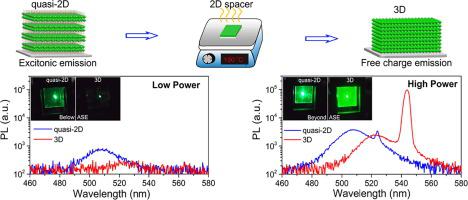Materials Today ( IF 21.1 ) Pub Date : 2021-06-11 , DOI: 10.1016/j.mattod.2021.05.002 Yang Li , Isabel Allegro , Milian Kaiser , Aditya J. Malla , Bryce S. Richards , Uli Lemmer , Ulrich W. Paetzold , Ian A. Howard

|
Among perovskite semiconductors, quasi-two-dimensional (2D) materials are attractive for the pursuit of electrically driven lasing given their excellent performance in light-emitting diodes (LEDs) and their recent success in continuous-wave optically pumped lasing. We investigate the spontaneous photoluminescence emission and amplified spontaneous emission (ASE) of a series of quasi-2D emitters, and their directly analogous 3D materials formed by removing the 2D organic spacer by annealing. Although the PL photoluminescence (PL) (at low optical excitation power) from quasi-2D films with high 2D spacer fractions can be much brighter than that from their 3D counterparts, the ASE thresholds of these quasi-2D materials tend to be higher. This counter-intuitive behavior is investigated through time-resolved photophysical studies, which reveal the emission in the high-spacer-content quasi-2D perovskite can be exclusively excitonic, and the exciton–exciton annihilation of quasi-2D perovskite starts to take over the exciton dynamics at a low exciton density (<1016 cm−3). To lower ASE thresholds in quasi-2D materials it is necessary to increase the volume fraction of thick quantum wells, which we achieve by decreasing the spacer content or by utilizing 1-naphthylmethylamine (NMA) linkers. The increase of the volume fraction of thick quantum wells correlates with an increased contribution of free carrier recombination to the emission process of the quasi-2D materials. These results suggest that material development of quasi-2D materials for gain applications should target fast free charge carrier recombination rates by engineering the well thickness and size and not maximum photoluminescence quantum yields under low power excitation.
中文翻译:

激子与自由载流子发射:对准 2D 和 3D 钙钛矿中光致发光效率和放大自发发射阈值的影响
在钙钛矿半导体中,准二维 (2D) 材料因其在发光二极管 (LED) 中的优异性能以及最近在连续波光泵浦激光方面的成功而对追求电驱动激光很有吸引力。我们研究了一系列准 2D 发射器的自发光致发光发射和放大自发发射 (ASE),以及它们通过退火去除 2D 有机间隔物而形成的直接类似的 3D 材料。尽管来自具有高 2D 间隔部分的准 2D 薄膜的 PL 光致发光 (PL)(在低光激发功率下)可能比来自 3D 对应物的要亮得多,但这些准 2D 材料的 ASE 阈值往往更高。这种违反直觉的行为是通过时间分辨光物理研究来研究的,16 厘米-3)。为了降低准 2D 材料中的 ASE 阈值,有必要增加厚量子阱的体积分数,我们通过减少间隔物含量或利用 1-萘基甲胺 (NMA) 接头来实现这一点。厚量子阱体积分数的增加与自由载流子复合对准二维材料发射过程的贡献增加有关。这些结果表明,用于增益应用的准二维材料的材料开发应通过设计阱厚度和尺寸而不是低功率激发下的最大光致发光量子产率来实现快速的自由电荷载流子复合率。









































 京公网安备 11010802027423号
京公网安备 11010802027423号